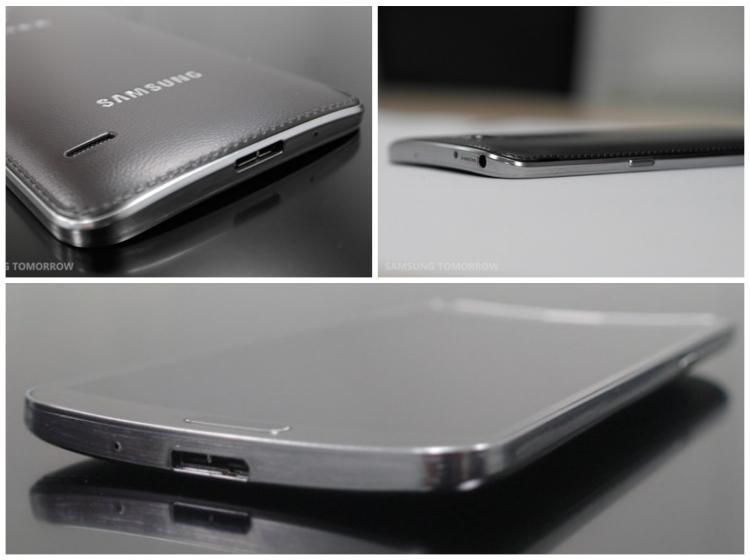
Smartphones, for the most part, have always had the same uniform shape and design when it comes to the screen: flat. And why would we expect any different? Screens are flat on most electronics. But they're flat because they can be. Televisions can become as big you want and never need a curved design, because you want the picture on the screen to be as easily accessible as possible. Even computer monitors have gotten larger and don't need a curved design, because as long as they're a safe distance away from your face, making them bigger just makes things easier to see. Phones, on the other hand, have gotten to the point where they almost need to be curved in order to be handled comfortably.
We've gotten used to having big screens. No, not even big screens anymore - huge screens on our phones. It started off with an iffy Galaxy Note device with a 5.3-inch screen, which many deemed to be just a little too large for comfort. But many found the device to be quite useful, and whether it was because of the larger screen, the return of the mysteriously missing stylus or perhaps a combination of both, we'll never know. But for whatever reason, the device just worked. It would be safe to assume that the size of the device wasn't an issue giving how popular it was becoming. So it was only natural to see how far you can push people by making the device even bigger with the Galaxy Note II. Again, the device was just as popular as ever.
It was only a matter of time before phones started getting as large as Samsung was making them it seemed. Of course, the "norm" was somewhere around 3.5 inches with the success of the iPhone, but Androids had a tendency to use larger screens. The HTC EVO 4G, for example, was one of the biggest phones I had ever seen when it was released. In fact, I had even considered it too big for comfort and went with a smaller device instead at first. If I were to hold it in my hand now, I would probably laugh. Actually, I'm fairly certain I still have one around here somewhere...
Yep, I do. And I laughed. Well, sort of.
It just takes one phone to be bigger than normal in order to raise a challenge. "Oh, you think you have the biggest phone at 4.3 inches? No, we have the biggest phone! It's 4.7 inches!" "Oh really? Because my 5-inch device is making your 4.7-inch device eat our dust!" And so on and so forth. It's the same with having the thinnest phone, or the lightest. They're not really that important, but manufacturers really enjoy playing those features up. And quite frankly, when we have to start curving our phones to make them more comfortable, perhaps we have reached the point where phones really have gotten too big.
The Samsung Galaxy Round was officially announced as being a real phone just a couple of weeks ago, being the first truly curved glass phone we see on the market. The Galaxy Round's screen is noticeably curved up on the two longer sides of the device, which is supposed to make it easier to hold in the hand. You would think that this type of screen may have been more beneficial for a phone like Samsung's Galaxy Mega 6.3, but the Galaxy Round actually only has a 5.7-inch screen. It's still a rather large device, and I could certainly see the need for a curved screen. I've expressed before that I am actually intrigued by the Galaxy Round's design and features.
But not too long after the Galaxy Round pops up, LG comes out with their competing device, the LG G Flex. The G Flex takes a different approach to the curved display, and instead of making the curve go from each side flank, the curve goes longways. But just by looking at the phone, I feel that doesn't really solve the issue at hand, the purpose of a curved display.
The curved display seems like it is being put into place to help make holding such large devices more comfortable. It's kind of like why the HTC One has a slightly curved back. In my opinion, it helps, even if just a little bit. But with the more noticeable curve in the Galaxy Round, I feel like it would make a really big difference; not only in making the device easier to hold with the curved back, but also by making the device slightly narrower. You would be amazed at how far a little narrowness can go when it comes to the ease of holding a phone. But the G Flex's curved display doesn't seem to do a whole lot to solve the issue that big phones are facing.
It will be interesting to see if either design even becomes popular. I predict that the Galaxy Round will be more popular, not just because it's coming from Samsung, but also because of its design compared to the G Flex. I can see more usefulness coming from the Galaxy Round's approach to a curved display rather than the G Flex, but I suppose we'll find out which design really wins people over when the two devices are officially released.
Readers, what are your thoughts on these two different curved displays? Do you prefer the banana shape of the LG G Flex, or the more palm-appropriate design of the Galaxy Round? Let us know your thoughts in the comments below!
Images via Samsung Tomorrow, Phandroid, Android Headlines